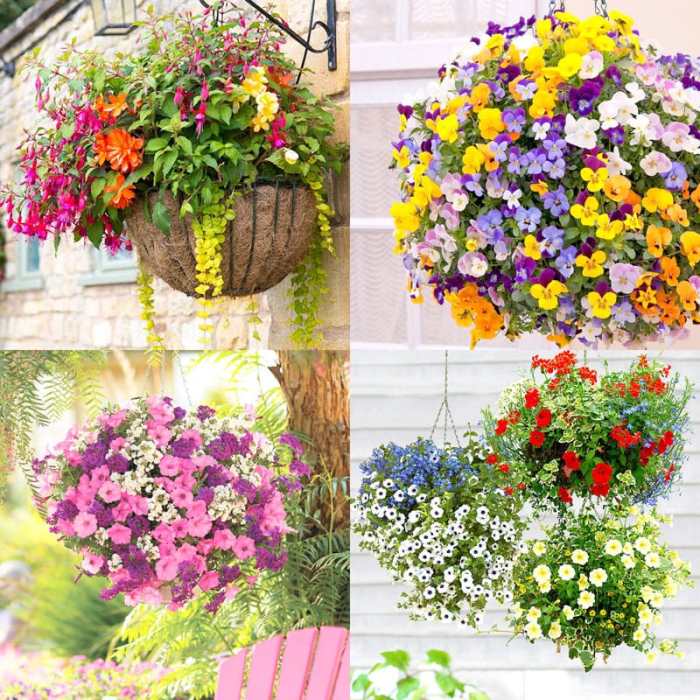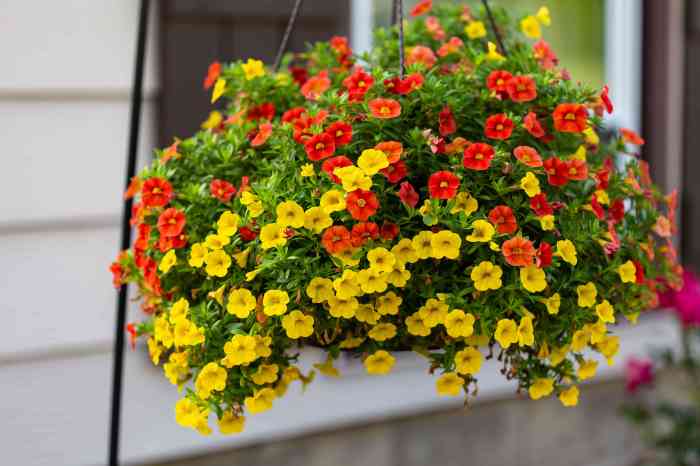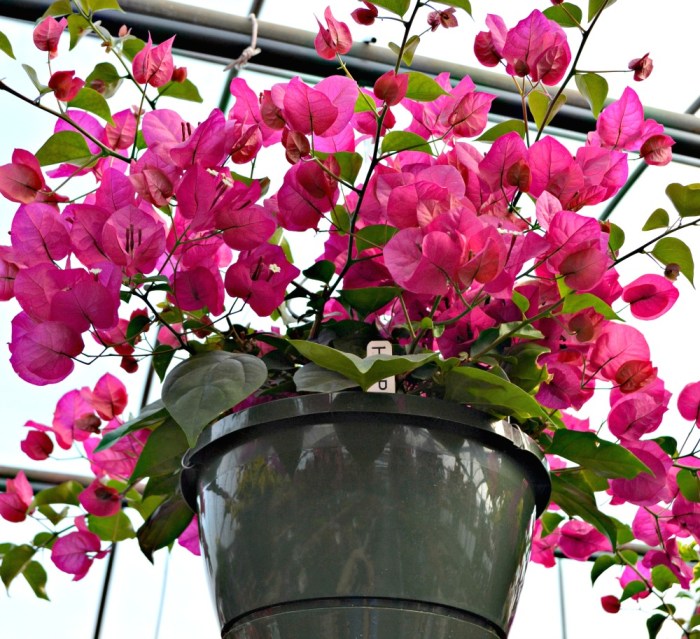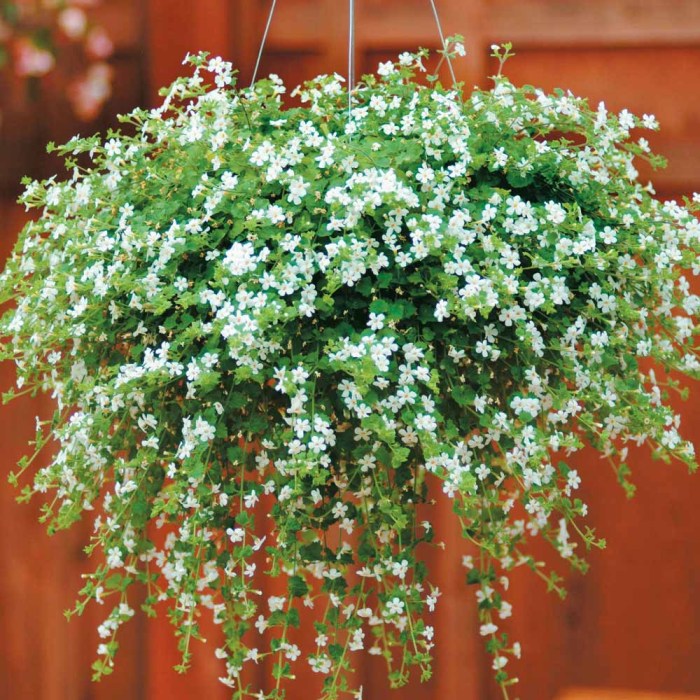Hanging plants for full sun add a touch of greenery and vibrancy to outdoor spaces, offering a unique way to display foliage and blooms. With careful plant selection and proper care, these sun-loving plants can thrive in even the brightest conditions.
From cascading petunias to trailing succulents, there’s a wide range of hanging plants that can withstand full sun exposure. This guide will explore the best options, provide tips for hanging arrangements, and discuss essential watering and care techniques to ensure healthy and beautiful hanging plants.
Plant Selection

Hanging plants are a great way to add a touch of greenery to your home, and they can be especially beneficial in areas with limited space. If you’re looking for hanging plants that can tolerate full sun, there are a number of great options to choose from.
Here are a few of the best hanging plants for full sun:
Spider Plant
- Scientific name:Chlorophytum comosum
- Common name:Spider plant
Spider plants are one of the most popular hanging plants for full sun. They’re easy to care for, and they produce long, trailing stems that are covered in small, white flowers.
Trailing Lantana
- Scientific name:Lantana montevidensis
- Common name:Trailing lantana
Trailing lantana is a fast-growing vine that produces clusters of small, brightly colored flowers. It’s a great choice for hanging baskets or window boxes.
Trailing Verbena
- Scientific name:Verbena rigida
- Common name:Trailing verbena
Trailing verbena is a low-growing plant that produces clusters of small, purple flowers. It’s a great choice for hanging baskets or ground cover.
Calibrachoa
- Scientific name:Calibrachoa x hybrida
- Common name:Calibrachoa
Calibrachoa is a fast-growing plant that produces masses of small, trumpet-shaped flowers. It’s a great choice for hanging baskets or window boxes.
Bacopa
- Scientific name:Bacopa monnieri
- Common name:Bacopa
Bacopa is a low-growing plant that produces clusters of small, white flowers. It’s a great choice for hanging baskets or ground cover.
Hanging Arrangements

Hanging plants in full sun can add a touch of greenery and color to your outdoor space. There are a variety of methods you can use to hang your plants, each with its own advantages and disadvantages.
Macrame Hangers
Macrame hangers are a popular choice for hanging plants because they are both decorative and functional. They are made from knotted cords or ropes, and they can be hung from a hook or bracket. Macrame hangers come in a variety of styles, so you can find one that matches the décor of your home.
One advantage of macrame hangers is that they are adjustable. You can adjust the length of the hanger to accommodate the size of your plant. Another advantage is that macrame hangers are relatively inexpensive.
However, macrame hangers can be difficult to clean. They can also be damaged by the sun and rain, so they may not be the best choice for outdoor use.
Wall-Mounted Brackets
Wall-mounted brackets are another option for hanging plants in full sun. Brackets are typically made from metal or wood, and they are mounted to the wall using screws or bolts.
One advantage of wall-mounted brackets is that they are very sturdy. They can support the weight of even large plants.
However, wall-mounted brackets can be more expensive than macrame hangers. They can also be more difficult to install.
Ceiling Hooks
Ceiling hooks are a simple and inexpensive way to hang plants in full sun. Hooks are typically made from metal, and they are screwed into the ceiling.
One advantage of ceiling hooks is that they are very easy to install. They are also adjustable, so you can hang your plants at the desired height.
However, ceiling hooks can be less sturdy than wall-mounted brackets. They may not be able to support the weight of large plants.
Watering and Care: Hanging Plants For Full Sun
Ensuring proper watering and care is essential for the well-being of hanging plants in full sun. Factors like plant type, pot size, and climate must be considered to establish an appropriate watering schedule.
Regular watering is crucial, especially during hot, dry weather. Allow the soil to dry slightly between waterings to prevent overwatering, which can lead to root rot. Use lukewarm water and avoid wetting the foliage excessively.
Hanging plants for full sun, such as bougainvillea and lantana, require regular watering to thrive. To ensure your hanging plants receive the moisture they need, it’s crucial to know when to water them. Refer to our guide on when to water hanging plants for specific instructions and tips on determining the right watering schedule based on factors like plant size, soil type, and environmental conditions.
With proper watering practices, your hanging plants for full sun will flourish, adding vibrant colors and lush greenery to your outdoor space.
Fertilizing
Fertilize hanging plants every two to three weeks during the growing season with a balanced liquid fertilizer. Follow the instructions on the fertilizer label for the correct dilution ratio.
Pruning
Regular pruning helps maintain the shape and health of hanging plants. Remove dead or damaged leaves and stems, and prune back overgrown shoots to encourage new growth.
Other Maintenance
Inspect hanging plants regularly for pests and diseases. Treat any infestations promptly with appropriate insecticides or fungicides. Repot plants as needed when they become rootbound.
Sun Exposure and Protection

Hanging plants in full sun require careful attention to sun exposure and protection to thrive. While ample sunlight is crucial for their growth, excessive heat and UV damage can lead to stress and decline.
To ensure optimal growth and prevent sun stress, consider the following techniques:
Plant Placement
Adjust the placement of hanging plants to provide adequate sunlight while avoiding intense afternoon sun. Move plants to areas with filtered or indirect light during the hottest hours of the day.
Shade Cloths
Use shade cloths or netting to provide partial shade and reduce UV exposure. This is particularly beneficial for plants that are sensitive to direct sunlight or during extended periods of intense heat.
Misting
Regular misting of hanging plants can help cool them down and increase humidity, reducing the effects of sun stress. Misting is especially beneficial during hot, dry weather.
In the realm of gardening, hanging plants for full sun have long been a popular choice. However, a recent article titled Are Hanging Plants Out of Style? has sparked a debate about their continued relevance. Despite the ongoing discussion, hanging plants for full sun remain a practical and stylish way to add a touch of greenery to outdoor spaces.
Design Considerations
Hanging plant arrangements can elevate outdoor spaces with their vibrant greenery and aesthetic charm. Designing a cohesive and visually appealing display involves careful consideration of various factors.
One crucial aspect is the choice of plants. Selecting plants with complementary textures, colors, and growth habits creates a dynamic and visually interesting arrangement. For instance, pairing a trailing plant like a pothos with an upright succulent like an aloe vera adds depth and contrast.
Color Combinations, Hanging plants for full sun
Color plays a significant role in enhancing the aesthetic appeal of hanging plants. A harmonious color scheme can complement the surrounding decor and create a cohesive look. Warm colors like reds, oranges, and yellows evoke a sense of warmth and energy, while cool colors like blues, greens, and purples create a calming and refreshing atmosphere.
Plant Textures
The textures of hanging plants add visual interest and depth to the display. Combining plants with smooth, velvety leaves, such as succulents, with those having coarse or feathery foliage, like ferns, creates a captivating contrast. The interplay of different textures adds visual dimension and makes the arrangement more dynamic.
Overall Visual Impact
The overall visual impact of a hanging plant arrangement is determined by the size, shape, and arrangement of the plants. A balanced display with a mix of sizes and shapes creates a visually pleasing composition. Using larger plants as focal points and surrounding them with smaller plants adds depth and interest.
Hanging plants for full sun can add a splash of color and vibrancy to any outdoor space. Whether you’re looking for cascading vines or lush greenery, there are many options to choose from. Bunnings offers a wide range of bunnings baskets for plants that are perfect for hanging plants for full sun.
These baskets come in a variety of sizes and styles, so you’re sure to find one that fits your needs. And with their durable construction, you can be sure that your plants will be well-supported and looking their best.
Last Point

By following these guidelines, you can create stunning hanging plant displays that will bring life and color to your outdoor areas. Whether you’re a seasoned gardener or just starting out, this guide will empower you to select, arrange, and care for hanging plants for full sun with confidence.
FAQ Compilation
What are some popular hanging plants for full sun?
Petunias, lantana, geraniums, and succulents are all excellent choices for hanging plants in full sun.
How often should I water hanging plants in full sun?
Water hanging plants in full sun when the soil feels dry to the touch, about once a day during hot weather.
How can I protect hanging plants from sun stress?
Use shade cloths or mist the plants regularly to reduce sun stress.